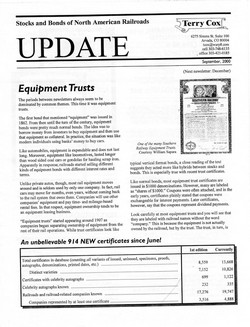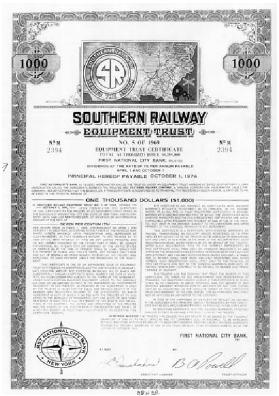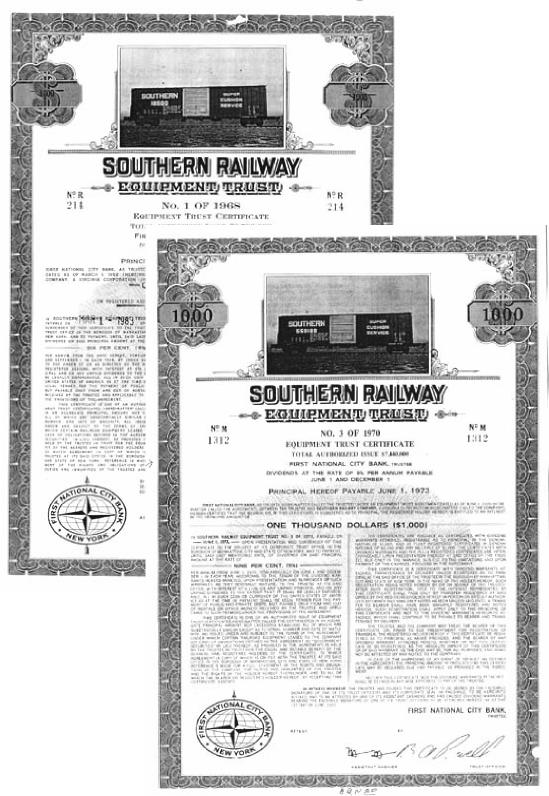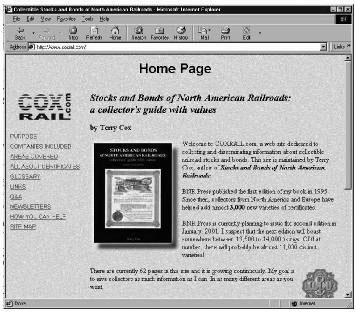
Equipment Trusts
The periods between newsletters always seem to be dominated by common themes. This time it was equipment trusts.
The first bond that mentioned “equipment” was issued in 1862. From then until the turn of the century, equipment bonds were pretty much normal bonds. The idea was to borrow money from investors to buy equipment and then use that equipment as collateral. In practice, the situation was like modern individuals using banks’ money to buy cars.
Like automobiles, equipment is expendable and does not last long. Moreover, equipment like locomotives, lasted longer than wood sided coal cars or gondolas for hauling scrap iron. Apparently in response, railroads started selling different kinds of equipment bonds with different interest rates and terms.
 One of the many Southern Railway Equipment Trusts. Courtesy William Sapara
One of the many Southern Railway Equipment Trusts. Courtesy William Sapara
Unlike private autos, though, most rail equipment moves around and is seldom used by only one company. In fact, rail cars may move for months, even years, without coming back to the rail system that owns them. Companies will use other companies’ equipment and pay time- and mileage-based rental fees. In that respect, equipment ownership tends to be an equipment leasing business.
“Equipment trusts” started appearing around 1907 as companies began separating ownership of equipment from the rest of their rail operations. While trust certificates look like typical vertical format bonds, a close reading of the text suggests they acted more like hybrids between stocks and bonds. This is especially true with recent trust certificates.
Like normal bonds, most equipment trust certificates are issued in $1000 denominations. However, many are labeled as “shares of $1000.” Coupons were often attached, and in the early years, certificates plainly stated that coupons were exchangeable for interest payments. Later certificates, however, say that the coupons represent dividend payments.
Look carefully at most equipment trusts and you will see that they are labeled with railroad names without the word “company.” This is because the equipment is not actually owned by the railroad, but by the trust. The trust, in turn, is commonly administered by a large New York-based bank or trust institution. It is always a little hard to decipher the exact intent, but in general, equipment trust certificates represent ownership of equipment that is leased to specific railroads.
The modern-day equivalent is the trend of people leasing their family automobiles from banks or manufacturers. Since large companies are in the business of leasing equipment, they gain tax benefits in the form of depreciation.
 Most of you have probably seen these Southern Railway Equipment Trusts certificates. But did you notice that the numbers on the boxcars were different? Trust No. 1 of 1968, at the top, has boxcar #18500. The certificate below, from Trust No. 3 of 1973, has boxcar #550180. Certificates courtesy of William Sapara
Most of you have probably seen these Southern Railway Equipment Trusts certificates. But did you notice that the numbers on the boxcars were different? Trust No. 1 of 1968, at the top, has boxcar #18500. The certificate below, from Trust No. 3 of 1973, has boxcar #550180. Certificates courtesy of William Sapara
From a cataloger’s standpoint, I have concluded that most trusts were entities separate from railroad companies, Consequently, most (but certainly not all) equipment trusts will appear in the next edition as separate companies.
Since the last newsletter, three or four major contributors sent me probably 30-40 new trust certificates. Some were tough to describe because they vary so minimally from each other.
The most obvious way to differentiate between equipment trust certificates are with series designations. They are usually lettered from A to Z, then AA to ZZ. I have not even come close to cataloging a complete series from any company.
Large companies issued many different trusts. So far, the best represented are the Southern and the L&N, both with 15 certificates apiece. I’m betting that the Southern issued at least 20 trusts. There is compelling evidence that the L&N issued at least 63 different series!!
Different series were generally, but not always, issued chronologically. For instance Series C certificates were usually issued after, or at the same time as, Series B certificates. However, series normally varied by redemption dates, interest rates, or both.
While I know that few people will respond, I will still ask. Do you have any equipment trust certificates? Would you send me copies? I don’t care how many duplicates I get. All I am asking for is a copy, reduced 60% to 70% to fit on an 81/2x11 sheet of paper. And please tell me the color.
An unbelievable 914 NEW certificates since June
|
1st Edition |
Currently |
| Number of certificates listed (counting all variants of issued, specimens, etc.) |
8,559 |
13,668 |
| Number of distinct certificates known |
7,152 |
10,826 |
| Number of certificates with celebrity autographs |
699 |
1,122 |
| Number of celebrity autographs known |
232 |
278 |
| Number of railroads and railroad-related companies known |
17,276 |
19,747 |
| Number of companies for which at least one certificate is known |
3,516 |
4,888 |
Text Portion of the Next Edition Completed
As I promised, I have completed the verbiage for the next edition and it is in the hands of the publisher. I am continuing to add new certificate listings as quickly as I can, to the tune of about 100 or more per month.
I know you want me to get as many new certificates into the next edition as possible. You may continue to send copies, and I will do everything I can to squeeze them in. Your submittals are my main priority for cataloging. Then come the many auction catalogs that I have backlogged.
And, if you’re wondering — no, it does not take a long time to convert from the database to the final form for typesetting. A few hours at most. So, of all the implied and actual deadlines, that is probably the easiest step to make.
Current Listing of Equipment Trusts
Of the 4,300 bonds currently listed in the database for the next edition, 173 mention equipment. Because of the nature of the hobby, I will never have complete information about every certificate. Nonetheless, it appears that 122 bonds are officially labeled as “equipment trusts.” The greatest variability among certificates, and the most challenging to unravel, occur with these companies:
Atlantic Coast Line Railroad Equipment Trust
Baltimore & Ohio (Railroad) Equipment Trust
Big Four Railway Equipment Trust
Canadian Pacific Railway Equipment Trust
Chesapeake & Ohio Railway Equipment Trust
Chicago Burlington & Quincy Railroad Equipment Trust
Chicago Indianapolis & Louisville Railway Co Equipment Trust
Chicago Milwaukee St Paul & Pacific Railroad Equipment Trust
Chicago St Paul Minneapolis & Omaha Railway Co
Equipment Trust
The Cincinnati New Orleans & Texas Pacific Railway
Equipment Trust
Clinchfield Railroad Equipment Trust
CSX Transportation Equipment Trust
Delaware Lackawanna & Western Railroad Co Equipment Trust
Denver & Rio Grande Western Railroad Equipment Trust
Erie Railroad Equipment Trust
Great Northern Railway Equipment Trust
Gulf Mobile & Ohio Railroad Co Equipment Trust
Interstate Railroad Equipment Trust
Louisville & Nashville Railroad Equipment Trust
Michigan Central Railroad Equipment Trust
New York Central Railroad Equipment Trust
New York Central Lines Equipment Trust
New York Ontario & Western Railway Co Equipment Trust
Northern Pacific Railway Equipment Trust
Pacific Fruit Express Equipment Trust
Seaboard Air Line Railroad Equipment Trust
Seaboard Air Line Railway Equipment Trust
Seaboard Coast Line Equipment Trust
Southern Railway Equipment Trust
Texas & Pacific Railway Equipment Trust
Union Pacific Equipment Trust
Western Maryland Railway Equipment Trust
I will re-iterate that I do NOT have complete information for any of these companies. Please consider helping by sending 81/2x11 copies of any certificates from any of these
companies. Or e-mail electronic copies. The more, the merrier. In fact, I will appreciate copies even if the certificates appeared in the first edition.
 Freunde Historicher Wertpapiere (Friends of Historic Securities) is an excellent German language auction catalog where many certificates appear that do not seem to be offered for sale in the U.S. Courtesy William Schooley.
Freunde Historicher Wertpapiere (Friends of Historic Securities) is an excellent German language auction catalog where many certificates appear that do not seem to be offered for sale in the U.S. Courtesy William Schooley.
The German Theme
Now that I think about it, there was a second theme for the past three months – German. Back in college, I had taken so much language that I almost got a second major in German. However, that was twenty-eight years ago. My grasp of German has gone from pretty darn good to non-existent.
Yet, there are some extremely rare items that appear in German-language auctions. And to catalog those items for the next edition, I must decipher German. And so must you, if you want to pick up some great rarities that only appear in European sales. What to do?
First, buy a good German-English dictionary. I find the college version of Harper-Collins dictionary pretty good. German has the habit of pasting one, two, even three, adjectives onto a noun to make one long word. Cheap dictionaries do not handle that tendency well.
I have found, however, that one online dictionary seems to do an admirable job with combination words and financial terms. It contains almost 230,000 words. and is very helpful. See it at http://dict.leo.org.
These two sources can help you understand catalog descriptions quite acceptably. Even if you have never taken a German course in your life.
And do not let the extra German characters – ä, ë, ï, ö, ß, ü – intimidate you. Unless, of course, you want to speak the language. Then, be very worried. (I learned long ago that my southern Indiana accent was incompatible with speaking German in a manner that humans could understand.)
New Website

After a long time planning, I finally have my web site up and running. It is dedicated entirely to information about collectible stocks and bonds. If you are online, please visit the site at www.coxrail.com.
Currently, the site is about 60 pages worth of information. It covers, in general form, many of the same issues I will address in the second edition. Including a lot of new stuff. Obviously, I cannot cover subjects in the same level of detail because web sites must convey information in small bits, very quickly.
One page lists certificate dealers that I know of. The goal, of course, is to help collectors find dealers more readily. And those dealers may not be in your country. Please send me the names of dealers I have missed.

I’m sure you are wondering whether the certificate database is available. Well...not quite yet.
Several problems need solving. First is the size issue. The database has grown to the point where it takes up too much space for posting on an ordinary web site. And believe me, without figuring out a way to pay for hosting, I cannot afford the luxury.
Another issue is the advanced scripting (code writing) it will take to allow users to access the database quickly and easily. I am not the least bit embarrassed to say that I do not have that skill.
Finally, I must make the information available in such a manner that it will enhance, not hurt, book sales. The book must exist for the thousands of collectors who are not online. And it must exist for the future. The only way that can happen is to do my part to keep my publisher profitable. You have heard me say it time and again, book publishing is NOT a high profit game.